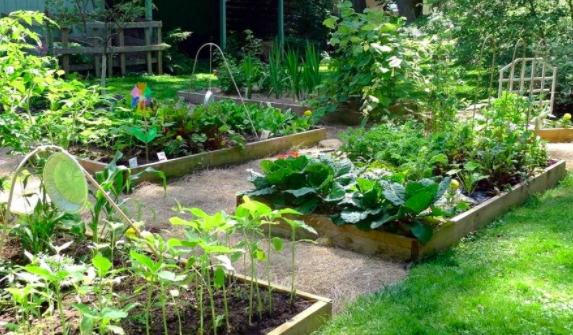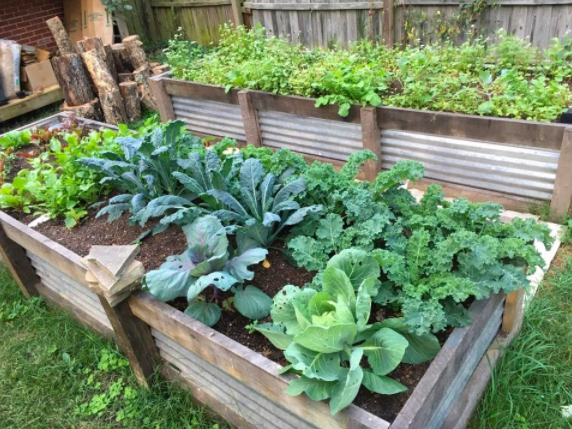Whether you live in the city or out in the country, the best way to have complete control over your garden is by building a raised bed. I say this because everyone’s soil is going to be different. It could be very sandy, loamy, high or low in nitrogen, or even solid red clay like mine is. The best way to overcome challenges presented by your soil is by building a garden bed on top of your existing soil.
The first step is determining the size bed you would like to build. I built my raised beds in a 4’ x 8’ design. We recommend 4’ or less in width so that you can reach the center of your raised bed without stepping into it. Length can be whatever fits in your available space. We also recommend a depth of 8” or greater. This will give your plants plenty of room for healthy roots. For lumber, cedar will last many years but is more expensive than other types of wood. Untreated pine is much less expensive than cedar, but may only last a few years depending upon conditions. The choice is yours!

If you don’t want to build a raised bed yourself, you may want to consider Smart Pot’s Raised Bed Planters. These fabric raised beds are inexpensive and make a great home for your plants.
Once you have decided on the dimensions or type of raised be you want, try to find an area that gets the most sun. Leafy greens and herbs can handle some shade throughout the day, but if you want to grow tomatoes, peppers, or other flowering plants, you will need full sun for those fruit productions.
After your raised bed is complete, you will need to fill it with soil. To determine how much you will need we need to calculate the cubic foot of the bed. Take the length x width x height to determine your cubic footage. Let’s take my 4’ x 8’ for an example. The height of mine is 1 foot, which makes my bed 32 cuft. That is going to take a lot of soil to fill, but I will only have to fill it once. I used a mixture of ProMix HP (peat moss, perlite, and a wetting agent) Happy Frog Soil Conditioner (Forest humus, worm castings, bat guano, beneficial microbes, and humic acid) Mushroom Compost (contains beneficial fungus) and Azomite (contains all of your micro nutrients). The quantities needed will depend upon the size of your raised bed. I went with a 40%/30%/30% mix of ProMix/Happy Frog/Mushroom Compost + 2.5 lbs of Azomite. Exact percentages aren’t too important–a good mix of these three base ingredients will do the job. If you don’t want to mix your soil yourself, Castline Organic Raised Bed Mix is an all-in-one solution.
After filling my bed, I only have to add 4-5 bags of compost and a 5lb bag of Azomite to my garden each year. I also like to use the Fox Farm Tomato & Vegetable nutrients to feed my plants through out the year. It contains several great amendments, which will feed your plants for 2-3 weeks at a time. They include: Alfalfa Meal, Feather Meal, Fish Bone Meal, Rock Phosphate, Bone Meal, Fish Meal, Sulfate of Potash, Kelp Meal, and Mycorrhizae. I like to top dress with this fertilizer every 10-14 days. That’s typically how long it takes for these amendments to break down and be available for your plants.

Raised beds can seem intimidating, but they can actually be pretty simple projects. We are happy to work with you to help you get the raised beds of your dreams. They are truly a great way to garden, allowing you to grow a lot of produce in a relatively small space and have a large amount of control over your planting space.
Happy Gardening!

Debra Lequieu says
Hello,
My name is Debra Lequieu. I live in Oklahoma & we have Red Clay for soil. We added many bags of compost & garden soil. We moved here from Nevada, last year. There is an existing garden here & I tried to grow roma tomatoes, pumpkin, russet potatoes, corn, spinach, chard & sunflowers. The only plants that survived, are the tomatoes, the corn is so sickly, green beans & lima beans, that are not producing beans but they flowered twice. The heat wave has been horrible here. Do you have any suggestions on how to improve the soil. What about planting them in a raised bed on stilts or wheels? How expensive would this be? We have only one fixed income & we are on 5 acres with our own well.
Thank you in advance
brian says
Thanks for reaching out Debra. Red clay is actually pretty good soil for gardening, but it does have it’s own challenges too as you are learning. The best thing I could recommend is to add a substantial quantity of compost to your garden and to mix it into the top layers of the soil. This will be a great source for slow nutrient release. More importantly, it will improve the structure and water retention properties of your garden. Red clay compacts easily and then doesn’t allow air and water to reach the root zone well. I’d say aim for adding 3″ of compost to get best results. If your garden is large, you may want to look into a bulk delivery from a landscape supply company locally. If smaller, garden centers will have a variety of composts available.
As for the raised bed question. They are great and the key benefit is that you get to control the soil mix 100% rather than work to amend the red clay. Many people choose to build their own raised beds to keep costs low and be able to customize. There are also great pre-made options available. Hope this helps and best of luck!